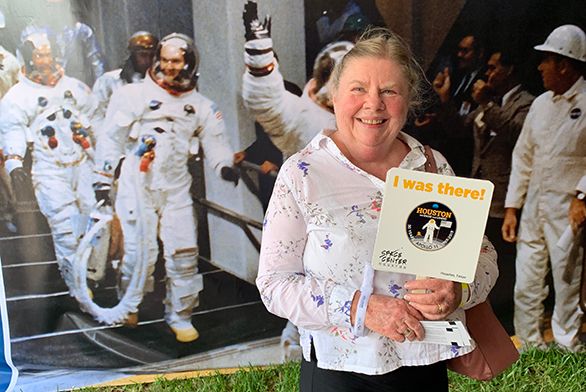Graduate Institute Alumna on Space, the Humanities, and Civil Discourse
September 6, 2019 | By Anne Kniggendorf (SF97)

Russia’s 1957 launch of Sputnik, the first artificial satellite to orbit the earth, was a defining moment for then-high school student Marilyn Roper (AGI94)—one which eventually led her to work on the Gemini and Apollo space programs.
That launch, she says, led to national concern that the United States was behind Russia not only in the space race, but in math and science in general. A strong student who had won a National Merit Scholarship, Roper felt her country needed her, and enrolled at Baylor University, where she majored in math and minored in physics and English.
In 1961, President John F. Kennedy announced his goal to send a man to the moon with the aim to bring him back safely before the end of the decade. As Roper recalls, “that sounded like the most exciting thing ever to me.”
Two years later, then, when an IBM recruiter came to Baylor in search of math and science students to work on the space program at the Manned Spaceflight Center in Houston, she eagerly applied, interviewed, and was hired to begin as soon she graduated in the spring. Roper was one of three women in a group of 14 trained in an accelerated course in machine assembly language and who joined other IBM programmers who had transferred to Houston from the Washington, DC. area.
IBM’s contract with NASA was to provide the computers and software for the Mission Control Center in Houston, where NASA Flight Controllers sitting at consoles during space missions would monitor all the systems aboard the space capsules, including the status of the astronauts aboard the capsules, to ensure everything was working properly and to alert the astronauts and the flight controllers of any problems.
Roper worked on the simulation programs, which were written to simulate normal mission stages as well as to simulate error conditions that the astronauts and flight controllers would have to deal with if problems arose.
After four years working at the Space Center, she transferred to Washington to work on a system for the National Security Agency and then transferred to Paris to work with IBM France on a proposal to SNCF, the French National Railroad. When the Apollo 11 mission occurred, Roper joined the family of the lead IBM France salesman on the SNCF account to watch, at 4 am French time, as Neil Armstrong descended from the Lunar Excursion Module onto the surface of the moon.
“Looking back on it, one thing that inspires me is that landing on the moon was an American achievement,” Roper says, “but it was something that the whole world rejoiced in. My French friends were every bit as excited as I was to experience that moment.”
She worked at IBM for 20 years before having a daughter, Allison (SFGI10), and making—along with her husband, also an IBM employee—the difficult decision to leave the work she loved in order to be with her daughter. The family moved to Annapolis. Roper missed the culture of DC—until she found herself on the campus of St. John’s College.
“I wandered into the bookstore on the Annapolis campus while my daughter was in school,” she remembers. “There I was, surrounded by books, and I curled up on an old black leather sofa and started reading. And I felt at home.”
Several years later, Roper enrolled in the St. John’s College Graduate Institute. It was, in many ways, a return for her.
“I had always been interested in everything,” she says. “When I chose to major in math and science, I wasn’t turning my back on the humanities or literature.”
She loved the conversations and the civil discourse among people with different opinions, which translated well into the next phase of her education: Education for Ministry (EfM), a four-year program of theological education for lay people and an extension program from the School of Theology of the University of the South in Sewanee, Tennessee.
Since graduating from the program, Roper has been leading diverse groups of people in theological literature discussions as a “mentor,” the EfM equivalent of a tutor.
“I try to emulate my St. John’s tutors as I lead the EfM groups,” she says. “I want everyone in the group, especially me, to listen to each other respectfully, to be open to learning and changing, and to grow. And so my experience at St. John’s continues to inform and enrich my life whatever I do.”

